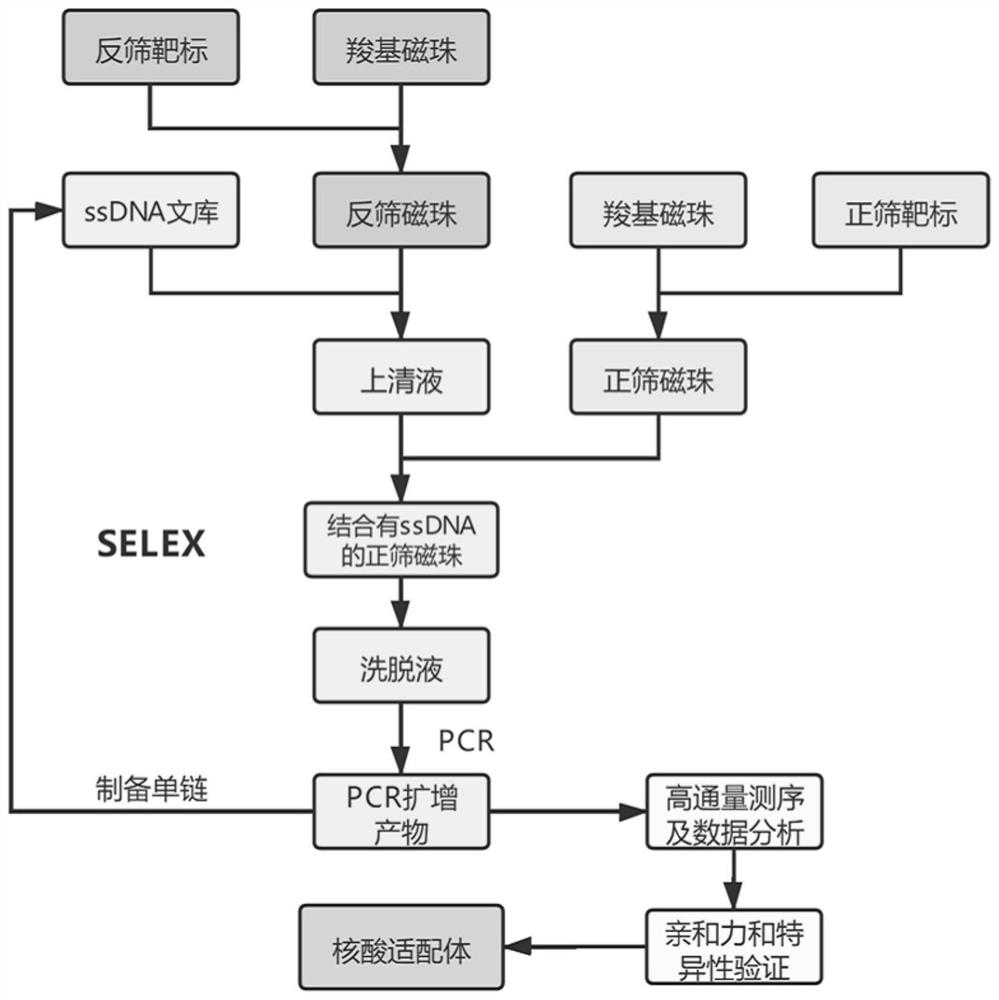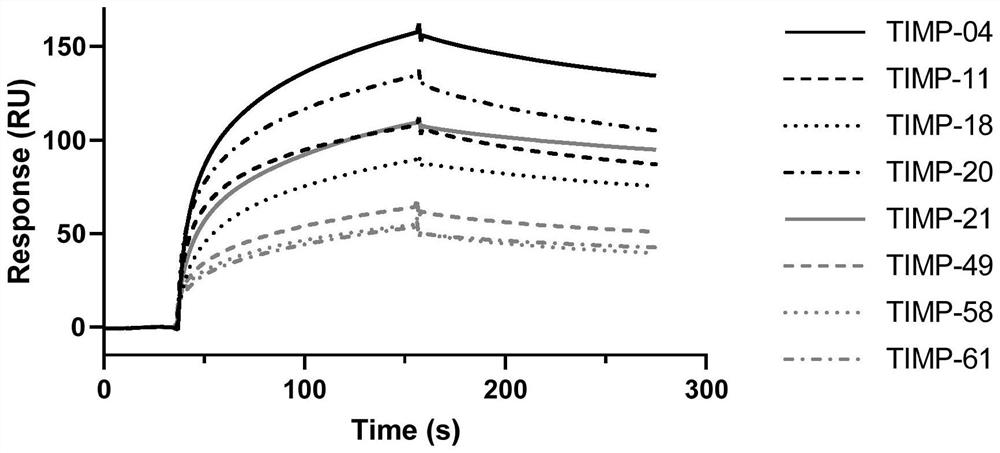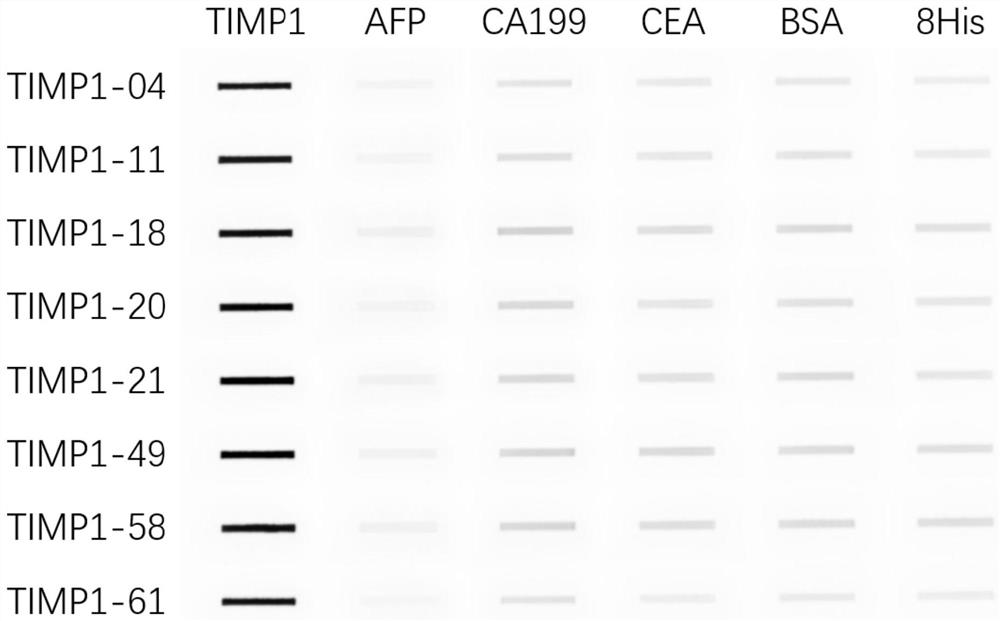Nucleic acid aptamer specifically binding to TIMP1 protein and application of nucleic acid aptamer
A nucleic acid aptamer and species-specific technology, applied in biochemical equipment and methods, instruments, analytical materials, etc., to achieve the effect of no batch difference, easy storage, and small molecular weight
- Summary
- Abstract
- Description
- Claims
- Application Information
AI Technical Summary
Problems solved by technology
Method used
Image
Examples
Embodiment 1
[0102] Screening of nucleic acid aptamers specifically binding to TIMP1 protein
[0103] 1. The ssDNA sequence that specifically binds to TIMP1 was screened from the ssDNA library by magnetic bead method to obtain an enriched library. The protein screening kit used was purchased from Anhui Aptamy Biotechnology Co., Ltd. (Product No.: SEP -201903);
[0104] a. Coupling the carboxyl magnetic beads with the positive sieving target and the reverse sieving target substance respectively after activation treatment, to prepare positive sieving magnetic beads and reverse sieving magnetic beads;
[0105] b. Incubate and separate the anti-screening magnetic beads and the random nucleic acid library to obtain the supernatant;
[0106] c. incubating the supernatant obtained in step b with positive sieve magnetic beads, and then washing and eluting to obtain an eluent;
[0107] d. Take the eluate for PCR amplification, and then prepare DNA single strands to obtain a primary library;
[0...
Embodiment 2
[0113] Surface plasmon resonance (SPR) detection of binding of TIMP1 nucleic acid aptamer to TIMP1 protein
[0114] 1. Dilute the nucleic acid aptamer SEQ ID No: 1-8 to 1 μM with DPBS buffer;
[0115]2. Coupling TIMP1 protein and 8His polypeptide to the first and second channels on the surface of the CM5 chip: first wash the chip with 50 mM NaOH, inject 30 μL at a flow rate of 30 μL / min, and then use an equal volume of EDC (1-(3 -Dimethylaminopropyl)-3-ethylcarbodiimide hydrochloride; 0.4M aqueous solution) and NHS (N-hydroxysuccinimide; 0.1M aqueous solution) were mixed and injected into 50 μL activated chip, Flow rate 10 μL / min. The TIMP1 protein and 8His polypeptide were diluted with 10mM sodium acetate at pH 4.5 to a final concentration of 50μg / mL before injection, the injection volume was 50μL, the flow rate was 10μL / min, the coupling amount of TIMP1 protein was 5500Ru, and the coupling amount of 8His polypeptide was 600 Ru. After the sample injection is completed, inj...
Embodiment 3
[0118] Nitrocellulose filter binding assay to verify the specificity of the nucleotide sequence shown in SEQ ID No.1-8 binding to TIMP1 protein
[0119] 1. Use PBS solution to dilute TIMP-1 protein, AFP protein, CA199 protein, CEA protein, BSA protein, and 8His polypeptide to 25 μg / mL;
[0120] 2. Use PBS solution to dilute FAM fluorescently modified to nucleic acid aptamers TIMP1-04, TIMP1-11, TIMP1-18, TIMP1-20, TIMP1-21, TIMP1-49, TIMP1-58, TIMP1-61 to 1 μM, Denaturation treatment: Denaturation at 95°C for 10 minutes, then immediately ice-bathed for 5 minutes, and then equilibrated at room temperature for 10 minutes;
[0121] 3. Mix the refolded nucleic acid aptamer with TIMP-1 protein, AFP protein, CA199 protein, CEA protein, BSA protein, and 8His polypeptide in equal volumes, and incubate at room temperature for 1 hour;
[0122] 4. Filter the incubated mixed solution through a nitrocellulose membrane (using a Bio-Dot SF microfiltration device), use an imaging system to t...
PUM
 Login to View More
Login to View More Abstract
Description
Claims
Application Information
 Login to View More
Login to View More - Generate Ideas
- Intellectual Property
- Life Sciences
- Materials
- Tech Scout
- Unparalleled Data Quality
- Higher Quality Content
- 60% Fewer Hallucinations
Browse by: Latest US Patents, China's latest patents, Technical Efficacy Thesaurus, Application Domain, Technology Topic, Popular Technical Reports.
© 2025 PatSnap. All rights reserved.Legal|Privacy policy|Modern Slavery Act Transparency Statement|Sitemap|About US| Contact US: help@patsnap.com



